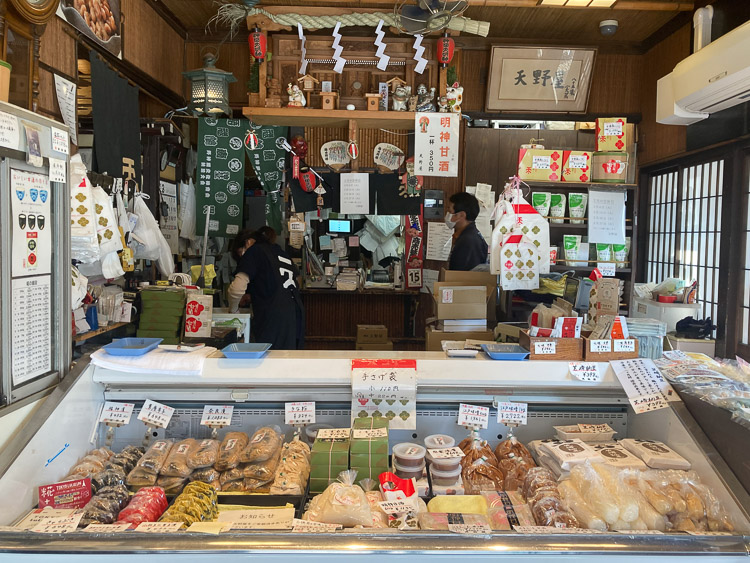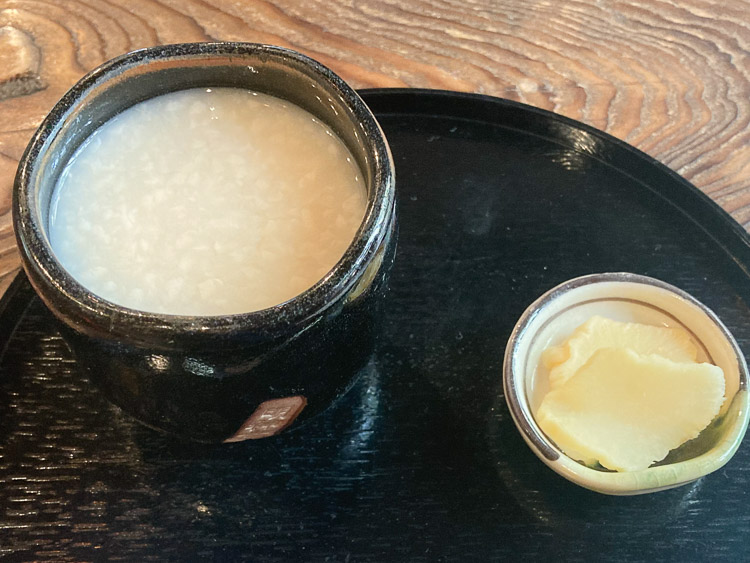ReservationSearch and reserve rooms
Click here to confirm, change or cancel your reservation
Shinkansen accommodation plan
提携法人専用予約
2024.03.16
"Amano-ya" - Enjoy sweet sake and feel like you've traveled back in time to the Edo period

Akihabara and Kanda area is a city where you can experience the atmosphere of Edo. Amano-ya, famous for its sweet sake, has been located next to the torii gate of Kanda Shrine for about 180 years since its establishment and is bustling with people who come to worship at Kanda Shrine.
Welcoming us at the storefront, which felt like a time trip to the Edo period, was Amano Fumiko, who runs Amano-ya.
He has over 50 years of experience serving customers at Amano-ya.

Amano-san is from Ibaraki Prefecture and has been working at the store since he was in the second grade of elementary school, due to the influence of his older sister, who is 14 years older than him and married into Amano-ya.
"I would come to Amano-ya from my parents' home in Ibaraki Prefecture on weekends and during summer holidays. I had to run a shop during the day, so no one would come and play with me until nighttime. Gradually, I started helping out at the shop," she recalled with nostalgia.
Following the wishes of her parents, who thought it would be safer for both sisters to marry into the same family, she married the younger brother of the fifth-generation owner of the Amano family (Amano's brother-in-law). Since then, she has lived her life alongside Amano-ya for over 50 years.
The koji room, an essential part of Amano-ya's koji production
 Koji room (provided by Amano-ya)
Koji room (provided by Amano-ya)
Koji is essential for Amano-ya's Amazake. The process of making koji, in which rice is inoculated with koji bacteria and left to sit and mixed evenly, is carried out in an underground room called the koji room. The koji room was built at the same time as Amano-ya was founded. It is located six meters underground, and people passing by above ground have no idea about it.
When Amano-ya was first established, there were apparently more than 100 koji rooms in the area around the restaurant. As times changed, the number decreased, and now Amano-ya is the only place in Tokyo's 23 wards where a functional koji room remains. It has also been recognized as a tangible cultural property of Chiyoda Ward.
Amano's story also makes it clear just how valuable the koji room is.
"Although the area was not affected by natural disasters such as the Great Kanto Earthquake, it was reclaimed to protect the ground when the surrounding high-rise buildings were constructed, and the area of Amano-ya's koji room gradually became smaller. It is now about one-fifth of what it was when the company was founded."
 Drawing of the koji room from 1904 (provided by Amano-ya)
Drawing of the koji room from 1904 (provided by Amano-ya)
Amano continues:
"Currently, only two people are allowed to enter the koji room: the seventh generation Amano-ya president and the production manager. Even I cannot enter. This is because the koji bacteria that live in the room are vulnerable to bacteria from outside."
Furthermore, koji making is easily affected not only by the environment of the koji room, but also by the season and weather. The mixture of rice and koji bacteria and the fermentation state are judged by touch, sight, and sound. It is supported by the experience of the production staff. There is no recipe, and it is passed down by learning by body.
Having overcome many hardships, we have continued to make koji from the time of our founding to the present day.
Koji builds relationships with customers

The cafe is decorated with the collections of the previous and previous owners, making you feel as if you have traveled back in time several decades.
Mr. Amano talked about the customer base, saying, "The Akihabara and Kanda areas are seeing an increase in urban-like buildings, but many customers are pleased with the atmosphere at Amano-ya. In recent years, not only old friends but also students and foreign tourists have been spending time here relaxing."

Amano-ya also sells koji and amazake in stores so that you can enjoy them at home. They also sell miso paste made with koji.
"Originally, we didn't sell miso. But one time a customer who tried the miso dengaku served in the coffee shop said, 'It's delicious, please share your miso with us,' so we started selling it," he told us the story.

"Edomae miso" made with koji
By having people try Amano-ya's koji, amazake, and miso, they will become part of the flavors of each household. They also seem to be happy that the flavors are being passed down from parents to children and grandchildren.
Plus, here's another happy episode.
"The grandchild of an old customer came to buy amazake as a birthday present for her grandmother. I'm happy that the flavors of Amano-ya can be enjoyed at family celebrations."
 "Myojin Amazake"
"Myojin Amazake"
You can eat it as is without diluting it with hot water.
What Amanoya's Amazake Teaches Us

Amazake available in the coffee shop
Served with homemade pickled radish
Amano also spoke about the future of Amano-ya.
"As the size of the koji room has decreased, the amount of koji we make has also decreased. We have no plans to expand it again. We are focusing on the task at hand and will continue to deliver the unchanging Amano-ya flavor."
Amano-ya's Amazake teaches us that change isn't everything, and that it's important to continue to protect what is in front of us.

天野屋
電話:03-3251-7911
住所:東京都千代田区外神田2-18-15
アクセス:JR 御茶ノ水駅から徒歩5分/東京メトロ千代田線 新御茶ノ水駅から徒歩5分/東京メトロ 丸ノ内線 御茶ノ水駅から徒歩5分
HP:http://www.amanoya.jp
*営業時間や定休日についての詳細は、上記リンク先にてご確認ください。




